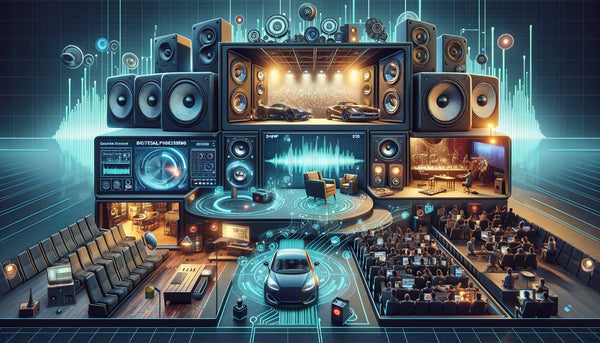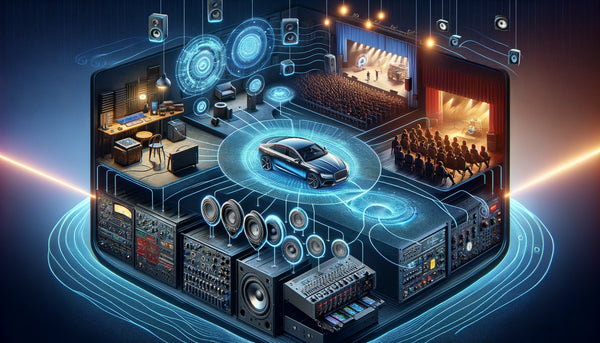DSP audio digital signal processing has dramatically transformed our acoustic environment, enabling the crystal-clear and immersive audio experiences we expect in modern life. From the music, we lose ourselves to the movies that captivate us and the advanced noise cancellation that allows uninterrupted listening. This technology is at the heart of today's audio innovation. The unseen force enhances the sound across devices, making every auditory detail crisp and impactful.
This guide delves into the intricate world of audio-digital signal processing, unraveling the complex digital algorithms that manipulate sound. For enthusiasts and audio professionals alike, understanding how DSP audio processing refines and reshapes audio signals is key to appreciating the sophisticated auditory landscapes we encounter daily. The following sections will explore DSP's fundamental concepts, applications, and far-reaching impacts on our listening experiences, focusing on the processors and microcontrollers Analog Devices offers.
Demystifying DSP Audio Processing

Digital signal processing, often called DSP, is what is DSP audio—the manipulation, analysis, and transformation of digital audio signals. It involves processing sound waves, converting analog audio into a digital format, and applying mathematical functions such as "add", "subtract", "multiply", and "divide" to enhance audio quality. DSP algorithms, performed by a digital signal processor, are the heart and soul of audio processing, allowing us to improve signal quality, reduce noise, equalize audio, and create sound effects.
What level of DSP is used in most audio applications?
Real-time DSP is essential in audio applications as it enables immediate processing and manipulation of audio signals. This capability ensures a seamless and responsive user experience, particularly in applying effects, equalization, and noise reduction. Real-time DSP provides swift and accurate signal processing, vital in professional music production and consumer electronics. By leveraging this technology, audio applications deliver enhanced sound quality and transform how we interact with audio in real-time.
The Basics of DSP
Understanding digital signal processing requires grasping some fundamental concepts. Analog-to-digital conversion (ADC) and digital-to-analog conversion (DAC) are crucial processes in audio processing. ADC converts analog audio signals into digital data, while DAC converts digital audio back into analog signals for playback. Frequency response is another critical concept, measuring how audio devices respond to different frequencies. Signal processing algorithms like equalization, compression, and noise reduction are applied to audio signals to achieve the desired frequency response. The Fourier transform plays a significant role by breaking down complex audio signals into frequency components for analysis, equalization, and sound effects processing.
The Role of DSP in Audio
Digital signal processing (DSP) has revolutionized the audio industry, powering advancements in wireless headphones, earbuds, digital audio workstations, and consumer audio products. DSP algorithms enhance sound quality, noise cancellation, voice recognition, and user interface.
DSP algorithms are crucial for noise reduction, equalization, and bass enhancement in wireless headphones and earbuds, providing an immersive audio experience. They also enable voice recognition and speech processing for hands-free communication.
Additionally, DSP is essential in audio gear like mixing consoles, audio interfaces, and digital audio workstations. It allows real-time audio processing, effects, and sound manipulation, making it indispensable in the music production industry for achieving professional sound quality.
Decoding How DSP Works in Audio

Let's explore the fascinating world of digital signal processing (DSP) in audio. DSP is a complex process involving mathematical equations, algorithms, and electrical circuitry. It transforms analog audio signals into digital format by capturing and converting their nuances. This involves sampling, quantifying, and encoding the analog signal. The heart of DSP lies in the algorithms that process these digital signals and make them usable in the real world.
DSP algorithms perform various tasks, from filtering and equalization to compression and enhancement of audio signals. The electrical circuitry in DSP systems ensures efficient and accurate processing, maintaining audio quality. With DSP, audio processing surpasses analog systems, offering greater flexibility and control. This advanced capability allows for fine-tuning audio signals unprecedentedly, resulting in a richer, cleaner, and more immersive audio experience. In addition, DSP also allows for functions such as volume control, equalization, and user interface, making it a crucial component in audio technology with its power consumption efficiency. DSP is at the forefront of audio technology, constantly pushing sound reproduction and manipulation boundaries.
Acoustics Meets DSP: Tailoring Soundscapes

The art of shaping audio environments lies in the interplay between acoustics and digital signal processing (DSP). Acoustics, the study of sound properties, is crucial for our perception of audio. Combined with DSP, it enables precise and creative soundscapes tailored to specific spaces.
DSP algorithms analyze acoustic properties like reverberation and echo, making real-time adjustments to optimize sound. This synergy is vital for concert halls, studios, and home theaters where audio quality is paramount. By leveraging DSP, engineers can correct anomalies and enhance clarity, delivering sound as intended.
The intersection of acoustics and DSP goes beyond traditional listening environments. In virtual and augmented reality, creating an immersive auditory experience is crucial. DSP algorithms simulate acoustic environments with binaural audio and spatial sound processing, enveloping the listener in a 360-degree soundscape.
This technology is revolutionizing fields beyond entertainment, such as architectural acoustics. By integrating DSP with acoustic principles, audio professionals can create lifelike audio experiences using digital precision.
Integrated Excellence: The Rise of Built-in DSP
The advent of built-in DSP has marked a transformative shift in how we interact with our audio devices. No longer confined to professional studios, DSP technology is now a staple feature in various consumer electronics, from smart TVs to portable speakers and even in our smartphones. This integration signifies a leap towards sophisticated sound processing within the device, allowing for enhanced audio performance without needing external equipment. Built-in DSP chips, also known as single-chip solutions, empower devices to provide real-time audio optimization, adaptively tuning the sound to the listener's preferences and the acoustic characteristics of the surroundings. It's a leap towards democratizing high-quality audio, providing everyone access to personalized listening experiences that were once a luxury.
Stereo DSP: Crafting Dimensional Audio Experiences
Stereo DSP technology enhances the stereo experience by creating a sense of space and movement. It widens the soundstage, localizes instruments and vocals, and preserves the warmth and dynamism of live music. With Stereo DSP, listeners can experience the full emotional spectrum of audio as if they were in the recording room, thanks to its full range capabilities and advanced Dirac Live room correction technology.
DSP-Free Audio Equipment: Exploring Audiophile Choices
Exploring audiophile choices, DSP-free audio equipment offers a pure analog signal path unaffected by digital processing. Enthusiasts prefer this setup for its authentic sound reproduction, free from the alterations that digital signal processing might introduce. By eliminating DSP chips, these systems maintain the audio signal in its analog form, catering to purists seeking the most natural sound output. This choice emphasizes sonic clarity and fidelity, appealing to those who value the raw and unadulterated audio experience.
Comparing DSP and CPU: Understanding the Differences
Digital Signal Processors (DSP) and Central Processing Units (CPU) play vital roles in audio processing. While CPUs are designed for general-purpose computing tasks, DSPs are optimized for performing mathematical functions on digital signals with high efficiency. DSPs excel in real-time audio processing, offering low latency and power consumption, making them ideal for audio products like wireless headphones. Conversely, CPUs are better suited for a wide range of tasks beyond signal processing, such as running operating systems and applications. Understanding their varied capabilities is essential for choosing the right technology for specific audio applications.
Activating Audio Excellence: Enabling DSP Processing

Activating DSP processing unlocks the full potential of audio devices, allowing users to customize their soundscapes. It can be as simple as selecting a preset or customizing settings in an app or software. This feature empowers users to adjust bass and treble and activate noise cancellation. It democratizes sound quality by allowing listeners to fine-tune frequencies and effects. Enable DSP processing to experience professional audio engineering at your fingertips with the help of the powerful db processor.
Exploring DSP Effects: From Subtle Adjustments to Dramatic Transformations
DSP effects are essential tools for audio engineers and enthusiasts. They offer many possibilities, from subtle reverberations to dramatic modulations. DSP allows for the emulation of vintage equipment and the creation of new, experimental audio landscapes. Whether cleaning up a mix or broadening the soundscape, DSP effects help bring creative visions to life through plugins.
Practical Applications of DSP Audio

Digital signal processing (DSP) algorithms are used in various audio products to enhance the user experience. They refine and improve audio quality in devices like speakers and car audio systems, tailoring sound output to the environment and user preferences. DSP technology also plays a crucial role in noise cancellation, reducing unwanted ambient sounds for a more immersive listening experience. With real-time analysis and adjustment, DSP algorithms provide unprecedented audio fidelity and customization, resulting in a richer and more enjoyable experience. Some practical applications of DSP audio include EQ, compression, and active noise cancellation (ANC).
DSP in Active Noise Cancellation
Active noise cancellation (ANC) headphones rely on digital signal processing algorithms to analyze incoming audio signals, detect ambient noise, and generate inverse sound waves to cancel out noise. DSP algorithms play a crucial role in noise reduction, allowing users to enjoy music or focus in noisy environments without distractions.
DSP in Managing Volume Levels

Digital signal processing algorithms also contribute to managing volume levels in audio playback devices. These algorithms ensure consistent audio playback volume, equalization, and sound normalization across different audio sources, providing a seamless listening experience.
Digital signal processing algorithms significantly impact your music listening experience, enhancing audio quality, equalization, bass response, sound effects, wireless audio playback, and frequency range.
FAQ
Do audiophiles prefer to use DSP in their audio setups?
Audiophiles often have a nuanced view of DSP (Digital Signal Processing) in audio setups. While some audiophiles appreciate DSP for its ability to correct room acoustics and tailor the sound to personal preferences, others may prefer a more traditional, unaltered audio path to preserve the original recording's integrity. The preference for DSP among audiophiles can depend on individual priorities—whether they value the authenticity of the sound or the ability to customize and optimize audio for the listening environment.
How does DSP compare to traditional car audio systems? Is it a worthwhile investment?
DSP can offer significant improvements over traditional car audio systems, particularly in terms of sound quality, customization, and space efficiency. Traditional car audio systems might not provide the level of control and precision that DSP systems offer, such as fine-tuning equalization, adjusting time alignment, and controlling crossover settings. For enthusiasts who prioritize audio quality and customization, investing in DSP for a car audio system can be worthwhile, offering a tailored listening experience that traditional systems may not match.
Is there a difference between DSP and Digital-to-Analog Converters (DACs)?
Yes, there is a fundamental difference between DSP and DACs. DSP refers to Digital Signal Processing, a method of manipulating audio signals in their digital form to improve sound quality, add effects, or achieve other audio enhancements. On the other hand, a DAC (Digital-to-Analog Converter) is a device that converts digital audio signals into analog signals, which are necessary for playback through speakers or headphones. While DSP focuses on processing and enhancing the audio signal, a DAC's role is to convert the processed digital signal back to an analog form for listening.
Can DSP function like an equalizer in an audio system?
Yes, DSP can function like an equalizer in an audio system. One of DSP's many capabilities is to adjust an audio signal's frequency response, which is essentially what an equalizer does. DSP can be used to implement various types of equalization, such as graphic equalizers, parametric equalizers, and more, offering precise control over the tonal balance of the audio. This makes DSP an extremely versatile tool in shaping the sound according to specific needs or preferences, beyond the traditional capabilities of standalone equalizers.
Are there any disadvantages or limitations to using audio digital signal processing?
While audio digital signal processing offers numerous benefits like noise reduction and signal enhancement, some disadvantages include increased processing time, potential signal distortion if not properly implemented, and the need for complex algorithms that may be challenging for beginners to grasp.
Conclusion

DSP audio processing is crucial in enhancing the overall audio experience. Using advanced algorithms and techniques, DSP helps decode, manipulate, and optimize audio signals for improved sound quality. It allows precise control over various audio parameters, such as volume levels and noise cancellation, resulting in a more immersive and enjoyable listening experience. DSP technology has found practical applications in various industries, including music production, telecommunications, and automotive audio systems.
As technology advances, we can expect further innovations in DSP audio processing, leading to even better audio quality and performance. So, whether you're a music enthusiast or a professional audio engineer, understanding the principles and benefits of DSP is essential for unlocking the full potential of your audio devices. For more information, check our blog on Understanding Car Audio DSP.





